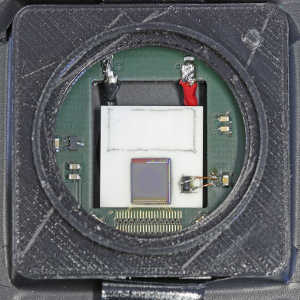Research Foci

Modern microelectronics allows for increasing complexity of functions realized with high-density integrated circuits. Beside fast digital functions, whole systems are intergrated on single chips. These can include sensors, analog amplifiers, filters, analog-digital converters etc. Without such chips and systems, which are highly optimized for a special task, many hardware projects are not realizable nowadays.
The Chair of Circuit Design, among other things, teaches technological basics and circuit aspects required for designs mixing digital and analog domains. An important basis for performant designs are exact understanding and accurate characterization of the basic building blocks and the parasitc effects in microchips. An essential Tool for prediction of circuit properties, beside mathematical modeling, is precise analog simulation. Complex, professional Design Software is used for implementation. The circle is closed by measuring real chip characteristics and comparing them with the expectations.
In cooperation with the Chairs of 'Computer Architecture' (Prof. TaheriNejad) and 'Novel Computing Technologies' (Prof. Koch), the specialization 'Hardware Design' is provided.
Research focus are chips and systems for the detection of x-rays, light and charged particle with applications in fundamental research, as well as medical engineering and industrial applications. Core components are application-specific microchips which are designed and commissioned in the group. Some ongoing projects are:
- Readout chips for PET scanners.
('PETA' chip family. Readout of SiPM sensors, time measument with 50ps resolution, charge measurement, intelligent data aggregation in multiple chips. Cooperation with various groups for building full PET scanners.) - DSSC X-ray camera for the XFEL.
(Collaborative project. 1000x1000 pixels, 5 millionen images / second for up to 800 images, ultra low noise of only ≈ 20 electrons by using DEPFET sensors) - Hybrid pixel detector for high energy X-Rays at ESRF (France) and DLS (UK).
(High dynamic range by using a novel charge pumping concept and pipelining, flexible on-chip processing, use of high-Z sensors (CZT).) - Charge readout for the TRD detector of CBM.
('SPADIC' multi channel chip with charge amplifiers, ADCs, hit-finding and serial readout to 'CBM-Net'.) - Single photon detectors for the search of rare physics events.
(Full custom chips with highly sensitive photo diodes (SPADs) with high fill factor, special data-driven low power readout architecture. Planned application in DARWIN project in liquid Xenon.) - Single photon arrays for reading out optical fibre bundles.
(Misalignment-tolerant architecture throiugh freely programmable SPAD groups. Potential application for calorimetry, particle tracking of beam-monitoring in radio-medicine.) - SPAD arrays for the NEXT experiment.
(Serial chip operation, Readout of UV photons with wavelength shifters) - Planned: Fluorescence measurement in biomedicine.
- Planned: Elektronen - detection for KATRIN (KIT).
- Planned: Elektron / Photon detection for electron microscopy.
Some more information can be found on the research page.